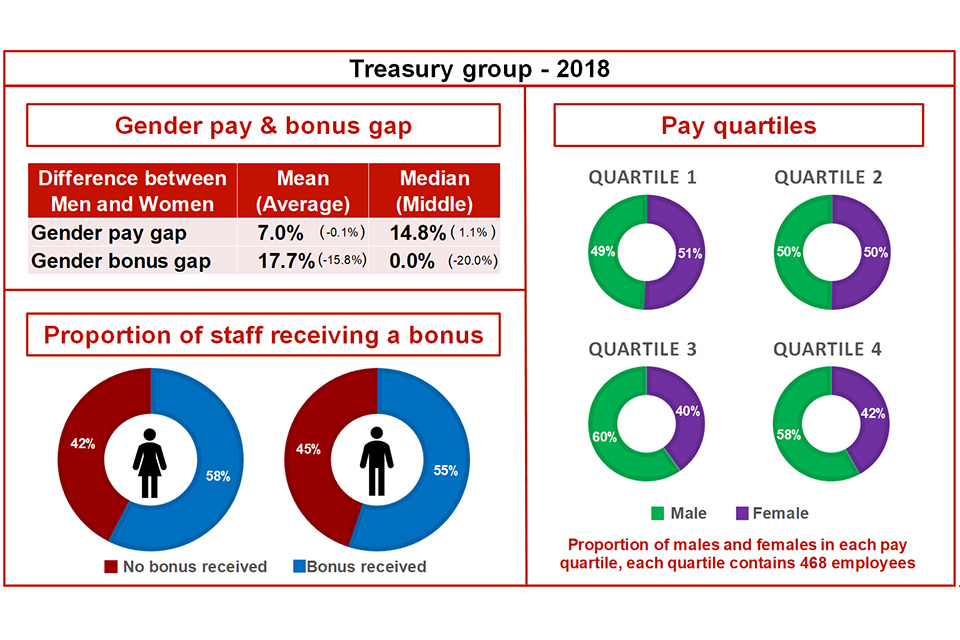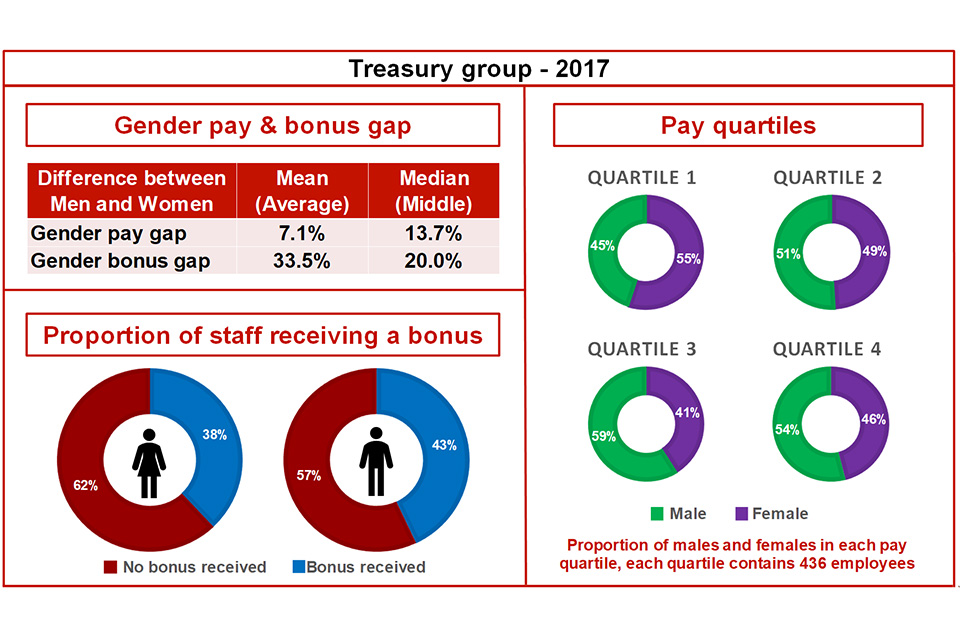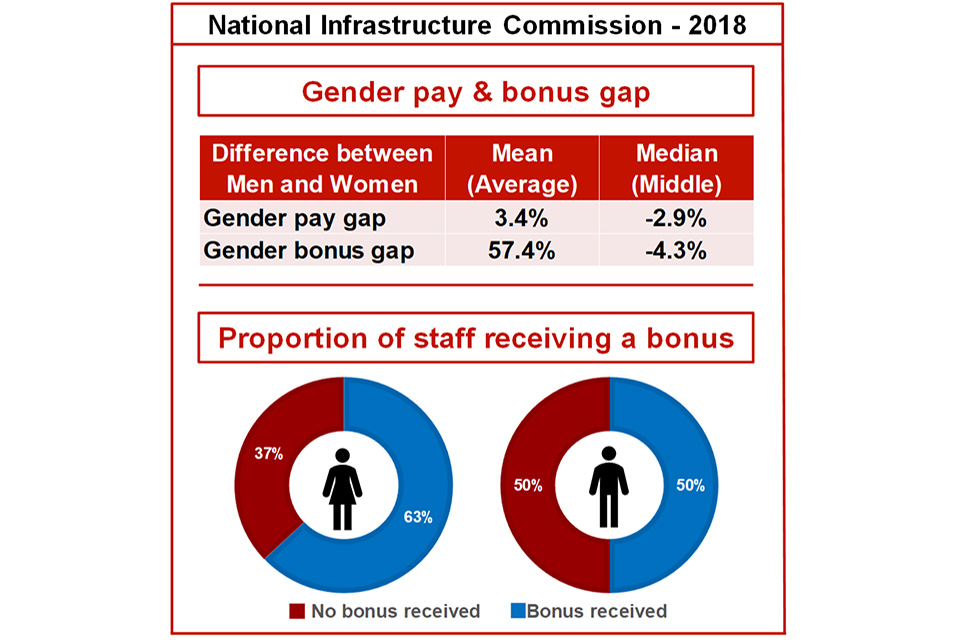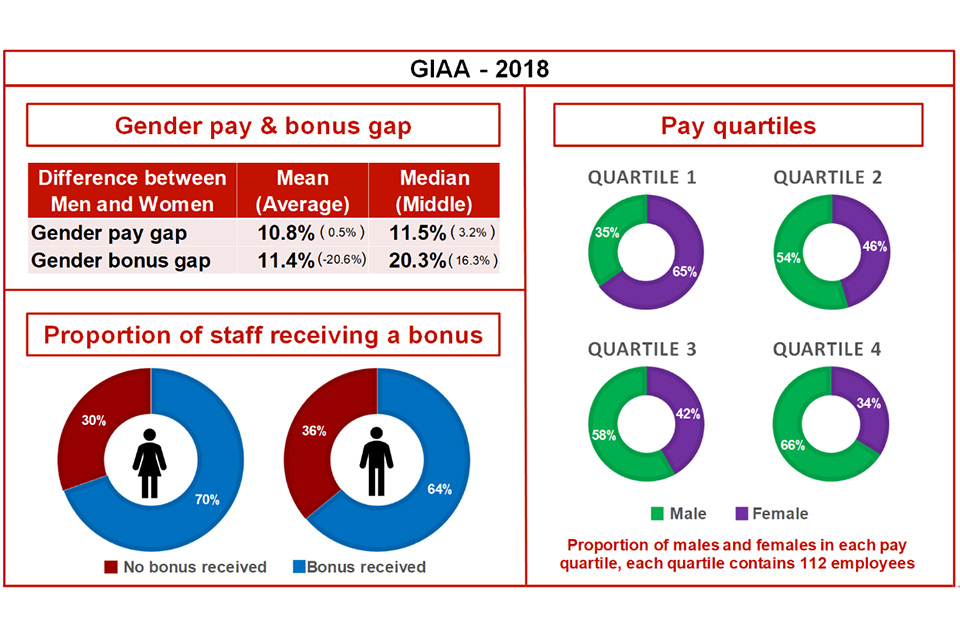Gender pay gap report 2017 to 2018: HM Treasury Group
Updated 4 January 2019
1. Introduction
In 2017, the government introduced world-leading legislation that made it statutory for organisations with 250 or more employees to report annually on their gender pay gap. Government departments are covered by the Equality Act 2010 (Specific Duties and Public Authorities) Regulations 2017 which came into force on 31 March 2017. These regulations underpin the Public-Sector Equality Duty and require relevant organisations to publish their gender pay gap by 30 March annually. This includes the mean and median gender pay gaps; the mean and median gender bonus gaps; the proportion of men and women who received bonuses; and the proportions of male and female employees in each pay quartile.
The gender pay gap shows the difference in the average pay between all men and women in a workforce. If a workforce has a particularly high gender pay gap, this can indicate there may be a number of issues to deal with, and the individual calculations may help to identify what those issues are.
The gender pay gap is different to equal pay. Equal pay deals with the pay differences between men and women who carry out the same jobs, similar jobs or work of equal value. It is unlawful to pay people unequally because they are a man or a woman.
The Treasury is committed to fairness. In particular, promoting equality of opportunity for all and a culture which values differences. As an employer, we want to ensure our workforce is representative of the community it serves and attract and retain talented employees from a wide range of backgrounds and with diverse skills and experience. We regularly publish information on the wider diversity of our workforce, including in the Treasury’s Annual Report and Accounts. The Treasury last undertook an equal pay audit in 2016.
2. Organisational context
Our aim is to build an organisation that is open to and supports and celebrates people from different backgrounds with different views and different ways of working; as well as to recruit, develop and retain a diverse workforce within an inclusive environment. As part of our Diversity and Inclusion Action Plan, we set out a number of areas of focus and key deliverables to achieve this vision.
Treasury uses a grading system which is linked to the Civil Service grades. For this report we will use the equivalent Civil Service grades, ranging from Administrative Officers to Senior Civil Servants. Within each grade there is a pay range, and irrespective of gender the longer someone remains in a grade the further along that pay scale they are expected to get. That being said, not all recruits start at the bottom of their pay range.
Also included in all figures unless otherwise stated are: Government Internal Audit Agency, Debt Management Office, and the National Infrastructure commission as Executive Agencies of the Department.

*Change from previous year shown in brackets

The overall mean gender pay gap for the Treasury Group has fallen by approximately 0.1% from last year to 7.0% The median pay gap has increased to 14.8%, an increase of approximately 1%, although this is still below the national median of 17.9%[footnote 1]. The bonus gaps are where we have improved the most, reducing the mean gap by nearly half to 17.7% and the median gap entirely to 0%, however we do recognise there is still progress to be made on this front. The increase in bonuses awarded across genders is a result of a pilot instant recognition voucher scheme, which gives managers the ability to reward employees with low value vouchers for good pieces of work.
The existing pay gaps do not indicate that men and women are being paid differently for equal work, but as the data below shows, there is a higher proportion of women in junior grades and lower representation at senior level, which affects the average and median pay for each gender. This has a greater impact on median pay which explains the difference between the mean and median pay gaps.
Treasury group
| Grade (increasing seniority) | Number of men (% of men who work in this grade) | Number of women (% of women who work in this grade) | % female |
|---|---|---|---|
| AA/AO | 36 (3%) | 40 (4%) | 53% |
| EO | 50 (5%) | 121 (13%) | 71% |
| HEO/SEO | 506 (47%) | 393 (43%) | 44% |
| Grade 6/7 | 421 (39%) | 308 (34%) | 42% |
| SCS (centrally managed only) | 70 (6%) | 56 (6%) | 44% |
| Total | 1083 | 918 | 46% |
There is also a disparity in the gender balance between the different organisations that make up the Treasury Group. The following table shows the proportion of men and women in each of those organisations.
| Organisation | % male | % female |
|---|---|---|
| HMT (exc. agencies) | 53% | 47% |
| GIAA | 54% | 46% |
| NIC | 56% | 44% |
| DMO | 63% | 37% |
2.1 Difference in methodologies
The Office for National Statistics (ONS) is the UK’s largest independent producer of official statistics and the recognised national statistical institute of the UK. Each year ONS undertakes two surveys and the published outputs include gender pay gap statistics. These are:
- Annual Survey of Hours and Earnings (ASHE)
- Annual Civil Service Employment Survey (ACSES)
It is important to note that the two surveys reference Gender Pay Gap but do not use exactly the same methodology to the Gender Pay Gap data contained in this report, which makes it difficult to make direct comparisons.
ASHE uses employee’s actual earnings, excluding overtime, and actual working hours during a specified pay period. ASHE uses this data to calculate the hourly rate which is used to calculate the national gender pay gap figures.
ACSES uses employee’s full time annual equivalent pay, excluding bonuses. This annual figure is used to calculate the gender pay gap. ACSES does not collect contracted hours and therefore, does not calculate hourly rate.
3. Closing the Gender Pay Gap
Below we have set out the actions that the central Treasury department is taking to close the gender pay gap. The effectiveness of these actions are reviewed regularly by HR and overseen by the Diversity Delivery Committee. Our executive agencies also have their own separate plans to help them address their own gender pay gaps.
3.1 Recruitment, retaining and developing a diverse workforce
The implementation of a new recruitment policy in January aims to improve fairness and consistency and upskill managers, removing bias in the recruitment process. Mixed gender selection panels will be made mandatory at both application sift and interview stages.
Treasury will continue to carry out ‘blind’ recruitment where all personal information including gender is redacted and not visible to those making decisions until the interview stage.
Treasury operates a ‘flexible by default’ approach to flexible working (such as part time working or job sharing). This means that by default, all jobs are advertised as open to those wishing to work part time or flexibly, with a review process requiring senior approval for any exceptions.
New training and guidance on recruitment will cover writing inclusive, un-biased job descriptions. This is being rolled out in 2019.
3.2 Progression and career paths
Treasury runs an annual talent round to track progression into and within the SCS, part of this is a review of diversity to ensure fairness and that all employees are being provided with the right development opportunities.
The Women in the Treasury network is closely involved in a number of initiatives to improve diversity and inclusion in Treasury. The network also holds events throughout the year to share experiences and provide a supportive community.
All employees will continue to be offered access to various talent programmes, aimed at supporting the right people into the right roles. These include: Future Leaders and Senior Leaders Scheme; Positive Action Pathway; and various apprenticeships.
3.3 Performance management
Treasury has a diversity panel which review the annual performance appraisal outcomes to ensure fairness.
Treasury is also reviewing its performance management processes, to ensure it is a truly fair and inclusive system.
3.4 Pay systems
Treasury has continued its strategy of shortening pay ranges and therefore improving internal equity.
Starting salaries for people joining is strictly monitored to ensure consistency and fairness of approach.
Treasury will carry out a full review of allowances, which will include an assessment into the consistency and fairness of our current system.
Treasury aims to improve transparency, through enhanced communications, on the overall pay system including: salary ranges, processes on promotion and the overall pay strategy.
3.5 Learning and development
Treasury is continuing to offer training courses including: diversity and equality courses, LGBT and disability confidence.
Additionally, Treasury is continuing to run its’ reformed Mentoring scheme, which currently has the highest take-up of the scheme to date.
3.6 Family friendly
The Treasury is a keen supporter of flexible working and continues to promote alternative working patterns. Policies relating to family leave have been updated to improve the experience of people taking leave in the Treasury.
All staff have the capacity to work from home, and improved IT systems now allow access to Treasury system via a USB-drive.
3.7 Governance
Treasury The Diversity Delivery Committee brings together the Executive Management Board diversity champions, the co-chairs of the Diversity and Inclusion Board and the Director of Corporate Services to lead and oversee the delivery of the Treasury Diversity and Inclusion Action Plan, which deliver initiatives aimed at developing and retaining a diverse workforce that fully reflects the Treasury’s values. To achieve the scale of transformation needed, diversity needs to become central to every major decision the department makes and mainstreamed into everyday activity and culture of every group and team.
3.8 Graduate scheme
Treasury is continuing to take steps to improve diversity on the HM Treasury graduate recruitment scheme, aiming to increase the numbers of females at each step of the selection process and attract more female applications. In the latest round of applications 52% of applicants were female.
3.9 Industry
The Women in the Treasury network is closely involved in a number of initiatives to improve diversity From an industry perspective, in 2016, the Treasury launched the ‘Women in Finance Charter’ which asks financial services firms to commit to implement four key industry actions. In full support of this initiative, the Treasury has signed the charter itself, which ties in with the target already set out in the Diversity and Inclusion action plan to increase the representation of women in Treasury’s Senior Civil Service to 50% by 2020, up from the current 44% (2016-17 42%).
4. Statutory disclosures
On 31 March 2018 HM Treasury had 4 employee entities, the central Department and three executive agencies: Government Internal Audit Agency, Debt Management Office, and National Infrastructure Commission. Only the central Department and the Government Internal Audit Agency employ 250 or more employees and their individual figures are shown below.
Due to the National Infrastructure Commission’s size their quartile data has been excluded.

*Change from previous year shown in brackets


5. Declaration
HM Treasury confirms that our data has been calculated according to the requirements of The Equality Act 2010 (Specific Duties and Public Authorities) Regulations 2017.
-
Office for national Statistics Annual Survey of Hours and Earnings: October 2018 results ↩
